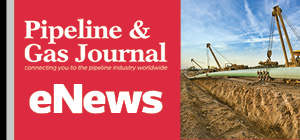DNV GL Publishes New HDD Standard for Pipelines
(P&GJ) — Oslo-based technical advisor DNV GL said it has published a new standard that reduces risk and improves quality of site investigation, engineering, planning and installation of pipelines using horizontal directional drilling (HDD).
The new standard, DNVGL-ST-F121, was created through a joint industry project (JIP) and provides a series of minimum requirements and best practice for all phases, from site investigation, engineering and planning to execution of pipeline installation to reduce the risk associated to HDD crossings.
“DNV GL brought together a multi-disciplinary group of experts that resulted in a new standard that has established clear parameters, limits and criteria for essential issues related to HDD projects,” said Frank Ketelaars, regional manager, Americas, DNV GL – Oil & Gas. “We are confident that this standard will bring long-term benefit to HDD operations, reducing risk and improving quality,”
The use of HDD installation techniques has grown significantly over the last decades. The 21st annual Underground Construction magazine HDD survey estimated in 2019 that contractors expected HDD to be applied to nearly half (47%) of their projects. However, HDD crossings are complex in nature and always challenging.
It is common to face problems during execution with significant impact on cost and schedule. The best way to overcome this is to ensure a proper investigation, engineering, planning and execution of all drilling-related activities.
Additionally, there are currently no methods for in situ repair of damaged pipelines installed by HDD, which makes it even more important to ensure the quality of pipeline design, construction and installation.
The earlier potential risks and problems are identified in an HDD project, the better for the delivery of the project.
All these challenges led to a joint industry project to consolidate the knowledge and experience of HDD. Operators, EPC companies and drilling contractors were brought together for the first time, addressing not only the borehole stability and the drilling activities perspective but also the aspects related to the pipeline integrity as well.
Related News
Related News

- Kinder Morgan Proposes 290-Mile Gas Pipeline Expansion Spanning Three States
- Valero Plans to Shut California Refinery, Takes $1.1 Billion Hit
- Three Killed, Two Injured in Accident at LNG Construction Site in Texas
- Tallgrass to Build New Permian-to-Rockies Pipeline, Targets 2028 Startup with 2.4 Bcf Capacity
- TC Energy Approves $900 Million Northwoods Pipeline Expansion for U.S. Midwest
- U.S. Pipeline Expansion to Add 99 Bcf/d, Mostly for LNG Export, Report Finds
- Enbridge Adds Turboexpanders at Pipeline Sites to Power Data Centers in Canada, Pennsylvania
- Great Basin Gas Expansion Draws Strong Shipper Demand in Northern Nevada
- Cheniere Seeks FERC Approval to Expand Sabine Pass LNG Facility
- Heath Consultants Exits Locate Business to Expand Methane Leak Detection Portfolio





Comments